|
Previously we mentioned planting a vegetable garden with your children and we hope that not only is your vegetable garden thriving, but that you’ve also considered planting flowers, keeping the natural pollinators, bees and butterflies in mind. Embracing nature and spending time outdoors with your family has so many benefits both physical and mental, and also builds a stronger family bond. It’s an established fact that children who spend more time outdoors are healthier, both physically and mentally, than their more indoor bound peers. Establishing a connection with the natural world early on is an essential, not-to-be-missed aspect of childhood and gardening is just one outdoor activity that the whole family can engage in and benefit from. Remember that gardening… Encourages healthy eating habits. Research has shown that when children participate in growing edible plants, they are more apt to try, not only the fruits and vegetables they grow, but also other fruits and vegetables. Getting kids in the garden and teaching them about where food comes from will naturally extend to having children in the kitchen assisting to prepare the food they have worked hard to grow, thus teaching your child valuable life skills. Introduces children to math and science concepts. Gardening is a perfect introduction to the Scientific Method, as children observe their plants grow and form hypotheses about how their plants will turn out. And just as each child is unique, so too is each plant. Different plants require certain types of soil, amounts of sunlight and water, spacing from other plants, and so on. That is science. Additionally, planning out a garden requires counting and measuring, perhaps even some construction if you are going to have raised garden beds. That is math. Working in the garden will provide your children with a basic foundation in important math and science skills that they can then carry with them to school.
Reduces stress and boosts confidence. It is a proven fact that gardening is a stress relieving activity. In fact, a recent study found that gardening is an even better stress reliever than reading (and that’s saying something)! Gardening can be a meditative, calming activity and can provide both children and adults with a sense of purpose and pride. Children will gain more self-confidence when they see that their hard work is paying off and benefiting themselves and others. Also, older children can use their own knowledge and skills to guide their younger siblings in the necessary tasks to take care of their garden. Teaches responsibility and patience. In this world of instant gratification, gardening can help teach children about the need for patience and the rewards that will come given a bit of time and effort. Additionally, children will learn that they have to be responsible and take care of their garden, water it daily, pull out the weeds, etc. or else their plants will not thrive. This sense of responsibility for their own small patch of earth can easily grow into a larger discussion on being a steward of the planet and how important it is to have a healthy planet to sustain life. Promotes family bonding. Gardening takes a fair amount of planning and organization and working on such tasks with your children will help to establish a deep bond between you. Involve your child in the entire planning process, allowing them to add their voice to the decisions that need to made, such as where the garden will be located, how large it will be and what you will grow. Gardening and reading will keep summer fun, productive and inspiring and can help to reduce the summer learning slide. Planting a vegetable garden will help to feed the family and teach children the importance of farms and flower gardens that attract natural pollinators will help to improve the bee population and keep that yummy honey flowing, not to mention the burst of color that is pleasing to the senses. Consider planting Bee Balm, Black-eyed Susan, Goldenrod, Butterfly Bush, Purple Coneflower, Snowdrops, Crocus, Salvia, Sunflowers and Roses to attract the pollinators. So bring on the vitamin D by spending time outdoors in a garden, even if it’s only on your patio or deck and enjoy the fruits of your labor! Extend the learning beyond the garden itself by connecting the experience with a great book like the ones listed below: *Note: this post contains Amazon Affiliate links. Any purchases made via the links provided will go to support our literacy efforts! 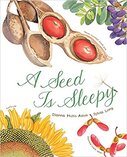 A Seed is Sleepy by Dianna Hutts Aston Poetic, lyrical text and beautiful, true-to-life illustrations make Aston’s series of science picture books a delight to share with children of any age. The large text that moves across the pages is sure to catch the eye and ear of younger listeners, while the smaller, informative pieces of text found throughout the book will appeal to older children. This book introduces a plethora of seeds to children, some familiar and others that may not be, and explains what a seed is, the different parts of a seed and how a seed grows to be a plant in a very accessible way. 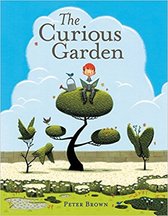 The Curious Garden by Peter Brown While taking a walk on a drizzly day through his very gray and dreary city, Liam comes upon a tiny, struggling patch of plant life up on the old railway. He decides to tend to the little patch and become its gardener. Although Liam does not know anything about being a gardener, he does his best and slowly learns all that he can about taking care of plants. Inspired by New York City’s High Line, Liam’s story shows us that anyone can be a gardener with a little patience and dedication. 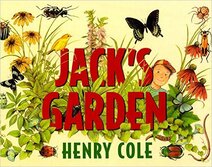 Jack’s Garden by Henry Cole Following the same building pattern and cumulative structure as the British nursery rhyme This Is the House That Jack Built, Jack’s Garden shows readers “the garden that Jack planted” from the initial preparation of the soil and planting of the seeds, to the beautiful blooms that are visited by bees collecting nectar. Each two-page spread shows Jack’s garden at a different stage of growth and features different things to be seen in the garden, such as a variety of garden tools at the beginning and the various insects found in the garden later on. The illustrations in this book are chock full of things to look at and talk about with your little gardener! 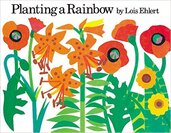 Planting a Rainbow by Lois Ehlert A young girl and her mother plant a rainbow each year. First they get bulbs and plant them in the fall, then order seed packets and get seedlings to plant in the spring. Then they watch their rainbow grow. The bold, colorful illustrations show the bulbs and seeds in the soil, giving readers a glimpse into the actual sprouting and growth process of the plants as the story moves along. 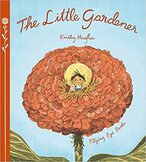 The Little Gardener by Emily Hughes The illustrations in this book are so captivating and, in our opinion, what really make this book such a gem. The little gardener loves his garden and works very, very hard to take care of it, but he is just too small to do it all on his own. One evening, he wishes on a star for some help and what happens next is so heartwarming. Through very simple text this story shows readers the value of hard work and that help can come from unexpected places. 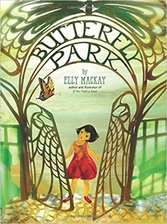 Butterfly Park by Elly MacKay There is no denying that this book is a work of art. Rather than traditional drawings or paintings for illustrations, this book features 3-D paper cut-outs, arranged on stunning backdrops, lighted for effect, and then photographed, giving each page depth and a life and character all its own. Much like The Curious Garden, this book tells the story of a little girl with a love of butterflies who moves from the country to the city. She is disappointed to discover that Butterfly Park does not actually have any butterflies in it and after several failed attempts to capture butterflies to populate the park, she realizes what the park really needs in order to entice the butterflies to stay: flowers! Eventually the whole community gets involved in turning Butterfly Park into a flower filled wonderland. 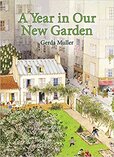 A Year in Our New Garden by Gerda Muller Anna and Benjamin have just moved to a new house in busy town. Although they are in the city, their new house has a large garden that the entire family cannot wait to work in. Each member of the family has a different plan for the garden and the book follows their progress and hard work over the course of a year. Sprinkled throughout the story readers will find information on gardening and plants, as well as activities and tips for spotting wildlife. The vintage style illustrations are gorgeous and begged to be pored over and viewed again and again. You and your child will be so excited to get out and work on your own garden after sharing this story! 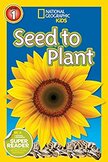 National Geographic Readers: Seed to Plant by Kristin Baird Rattini Brimming with full color photographs, this nonfiction title is packed with information on plants from defining what a plant is to explaining what plants need, how they’re used, depicting the growing process and even offering trivia like facts about various plants. Young botanists will love this one. Follow it up with National Geographic Readers: Plants by Kathryn Williams (a Co-Reader designed for an adult and child to read together) and A Seed is the Start by Melissa Stewart. 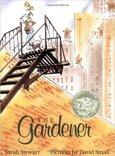 The Gardener by Sarah Stewart Through a series of letters written home, Lydia Grace Finch tells about her life in the big city living with her cantankerous Uncle and helping out in his bakery during the Great Depression. After working in the bakery all day, Lydia Grace spends her evenings putting her gardening skills to work in her secret place. The surprise she eventually reveals (in the hopes of putting a smile on her Uncle’s face) is a glorious rooftop garden. This book shows readers the joy that can be found through gardening. 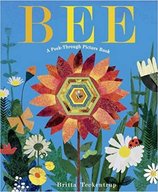 Bee: A Peek-Through Picture Book by Britta Teckentrup Peek through the hexagonal die-cut in the center of the book (that is reminiscent of a honeycomb) to see the busy little bee collecting nectar, spreading pollen, and doing her part to help plants grow. The gorgeous illustrations depict the little bee going about her day and the rhyming text explains in a simple, understandable way the vital role of the honeybee in our environment. This book is a great choice for introducing little ones to pollinators and helping children appreciate the need for them in order to have healthy gardens. 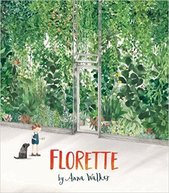 Florette by Anna Walker Following a similar theme as a couple of the other books on this list, this book tells the story of Mae, a little girl who moves from the country to the city with her family and desperately misses her garden and spending time out in nature. She attempts to bring nature back into her world, but the rain washes away her chalk drawings and her dad throws away the boxes she decorated with apple trees and daffodils. On a walk through the city with her mother, Mae sees Florette, a plant store that resembles a lush jungle and is thus inspired to create her own garden in the city. 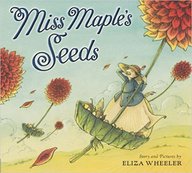 Miss Maple’s Seeds by Eliza Wheeler “Take care, my little ones, for the world is big and you are small.” There is great potential to be found within every seed. Each towering tree and beautiful flower was once a tiny seed and Miss Maple knows that some seeds just need a bit more time, care and encouragement in order to become the amazing plants they are destined to be. She collects seeds that have not found the perfect place to sprout yet and cares for them until they are ready to set down their roots. This is a thoughtful book with whimsical illustrations that will touch the heart of all those who read it. 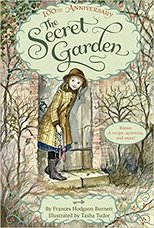 The Secret Garden by Frances Hodgson Burnett Mary Lennox, a sickly, selfish, unloved child, born to wealthy British parents living in India finds herself orphaned after a cholera epidemic. She is then sent to live in England with an uncle she has never met. At first she is just as rude as ever, but slowly she learns to enjoy the people of her new home and exploring the grounds. Eventually she discovers the secret garden of Mrs. Craven, her uncle’s deceased wife, and spends her time restoring the garden to its former glory. This chapter book is about the power of love, patience and compassion and is a classic of children’s literature So, get out into the garden with your child this summer. Take some books out there with you to read while surrounded by the beauty you have cultivated and cared for so meticuously. Not only will you and your child benefit from the shared storytime in the great outdoors, but so will your plants! Recent studies have shown that speaking to your plants actually helps them grow!
Happy gardening and reading!
0 Comments
Leave a Reply. |
AuthorWe are mom Sandra and daughters Amanda and Kate, all with backgrounds in literacy and education, who want to share our philosophy of taking the basics of life; books, simple toys that encourage play, imagination and creativity, and using cooking and baking to teach math and real life skills to raise happy, inquisitive children. Join us in exploring the old and the new and sifting through the myriad of research to consider what is best for our children. Archives
June 2022
Categories
All
|
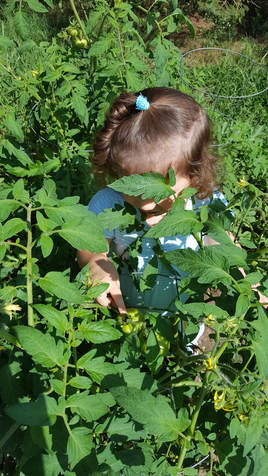
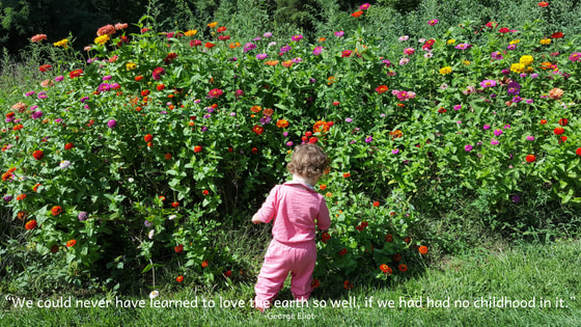
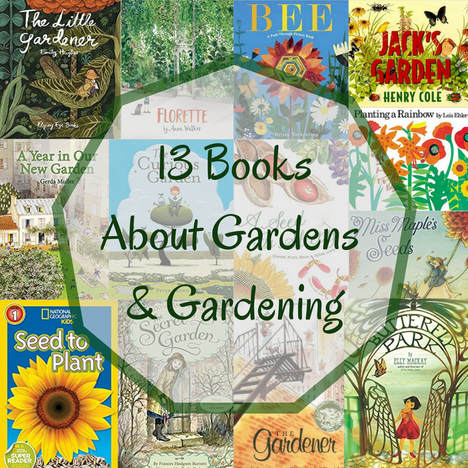
 RSS Feed
RSS Feed